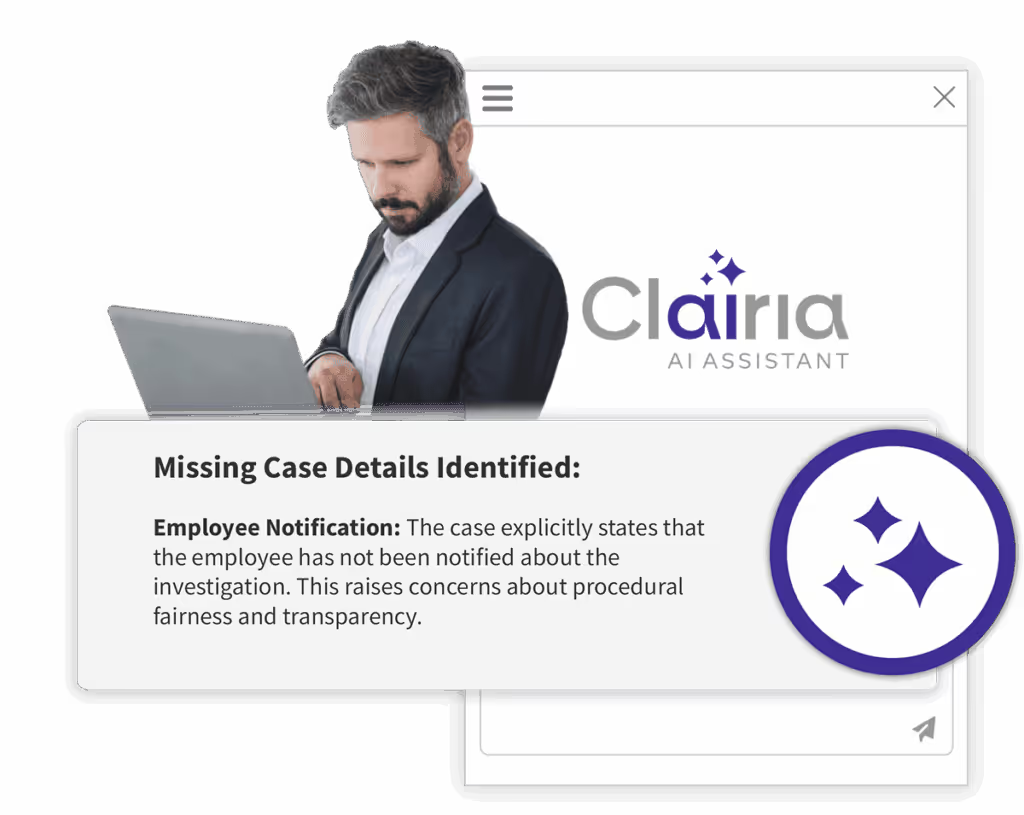How do you document your workplace investigations? Consistent, compliant and efficient documentation not only keeps your team organized, but also protects your organization if your processes are ever called into question in a lawsuit or by regulators.Your investigators probably use dozens of investigation case management templates daily to ensure their case documentation meets standards while working efficiently. Below, we list the top 10 case management forms, and discuss how Case IQ can help streamline your HR investigations.1) Complaint/Intake Form: This form document the initial complaint or report of an issue within the workplace. It should capture details such as the date, time and location of the incident, individuals involved and a brief description of the alleged misconduct. You should offer an anonymous reporting option on your reporting mechanism in case the reporter feels nervous bringing an issue to light for some reason (e.g. they fear retaliation, they were harassed by their boss).
FREE WHITE PAPER
Did you know that streamlining your triage process can improve the efficiency of your investigations overall?
Learn how in this free white paper from compliance expert Thomas Fox.
Get White Paper2) Incident Report: While the intake form captures information from a complainant, an incident report is more detailed and often completed by an investigator. It includes a full timeline of the incident, personal and contact information for all involved parties including witnesses and immediate actions that were taken after the incident occurred.3) Investigation Plan: An investigation plan outlines the scope and goals of the investigation, the timeline, each investigator's responsibilities and the steps to be completed during the investigation. Starting each investigation with a plan keeps it on track so you can resolve issues quickly and prevent repeat incidents.4) Evidence Log: Keep a log of all evidence collected during the investigation, including documents, emails, photographs or any other relevant materials. Note the source, date and description of each piece of evidence. If you use case management software like Case IQ, your evidence log is included right in the case file so you can easily access evidence at any time during the investigation.5) Confidentiality Agreement: Ask individuals involved in the investigation, including witnesses and the complainant, to sign a confidentiality agreement to protect sensitive information. This case management form is especially important for incidents involving personal details (such as sexual harassment) or financial details (such as theft and fraud).6) Conflict of Interest Disclosure Form: Investigators should disclose any actual, potential or even perceived conflicts of interest that could compromise the integrity of the investigation before they are officially assigned to a case. This form should reference your organization’s conflict of interest policy and explain the different ways an employee could be conflicted.7) Interim Action Plan: If applicable, document any interim actions taken during the HR investigation, such as suspensions, reassignments or other measures to ensure the safety and well-being of employees. Note the dates these actions were taken and reasons behind them, and have the employee sign the form, in case an employee tries to claim that you wrongfully disciplined them.8) Final Investigation Report: When the investigation is complete, compile a comprehensive report summarizing your team’s findings, conclusions and recommendations. This report should be well organized, easy to read, and include all supporting documents and evidence.
FREE TEMPLATE
Want to write better investigation reports in less time?
Use our free <a href="https://www.caseiq.com/resources/investigation-report-template-free-download/">investigation report template</a> to ensure you never leave out any key details.
Get the Template9) Notification Letters: Send notification letters to relevant parties, such as the complainant and the subject of the investigation, to inform them of the investigation's outcome and any actions taken. This case management form is important because employees might try to question or appeal your decision if they don’t agree with the outcome.10) Risk Assessment Form: A risk assessment helps your team take proactive action against future workplace incidents. Fill in this form with historical case data and details of your organization’s current processes to measure your risk of certain types of workplace investigations (e.g., harassment, security breach, discrimination, etc.).
FREE TEMPLATE
Need help getting started?
Download our free risk matrix template to find your gaps and areas of risk.
Get the TemplateWhich case management forms do I need?
Every organization is different. Based on your company’s size, industry and other factors, you might need all of the above case management forms, or only a few of them.While using forms to keep your documentation consistent certainly boosts efficiency, using case management software like Case IQ can improve your HR and ER investigations even more. Case IQ lets you configure forms to match your needs and processes in the platform, then saves them so you can access them right in your case files. This ensures investigators always use the most up-to-date version of a form and don’t waste time hunting for form documents.Want to learn more about Case IQ’s custom forms and investigation for case management templates? Click here to request a demo of Case IQ.
FAQ's
What is case management documentation?
Case management documentation is to the process of recording and organizing information related to a case or investigation in a structured and consistent manner.
What is an example of case management?
An example of case management might be following a harassment complaint from start to finish. You receive the complaint, log it, investigate it (including gathering evidence and conducting interviews), document findings, and write a final investigation report.
What does a case management note look like?
A case management note typically includes key details such as the date and time of the note, a summary of actions taken or discussions held, any decisions made, and the initials or signature of the person documenting the note.











